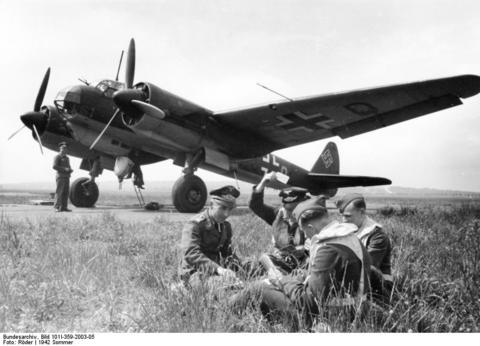Nazi Germany's Workhorse Twin-Engine Aircraft

World War Two Vehicles has posted some production figures for German aircraft. Though well known, in perusing through them once more one of the items that stands out is, of course, the sheer size of the JU-88 production program - with roughly 15,000-16,000 such aircraft produced by the Third Reich. Although best known in its role as a twin engine medium bomber, the Ju-88 manufactured by Junkers, also became one of the top multi-role aircraft of the Second World War; serving as a bomber, torpedo bomber, dive bomber, fighter-bomber, night fighter, heavy fighter, reconnaissance aircraft and more the Ju-88 was the most produced twin engine German aircraft of WWII.
In spite of its widespread use, the Ju-88 started off under auspicious circumstances, as its development ground forward through delay after delay. For instance, though having first flown late in 1936, the Luftwaffe did not put it's first Ju-88 squadron into the air until the onset of the Second World War. The Ju-88's developmental problems stemmed from a number of reasons including attempts to create additional roles for an aircraft whose initial design was tailored to the requirement for a fast, level flight, medium bomber. For example, though the Ju-88 proved quite adept as a dive-bomber; its airframe could not take the stresses imposed by vertical bombing, even after extensive modifications. That said, the Ju-88 could deliver ordnance with a high degree of accuracy in more of a "glide bombing" role, with the aircraft attacking at a shallower 45 degree angle; sparing the worst of the wear and tear otherwise imposed by dive bombing.
Beyond facing the burdens imposed by adding numerous roles to the Ju-88s initial mandate as a level flight medium bomber, came the normal issues associated with creating a mature combat aircraft. As such, when the Ju-88 saw its first significant combat, during the Battle for France and the Battle of Britain, it endured heavy losses - including the highest losses of any German level flight bomber deployed during the Battle of Britain in spite of the presence of fewer Ju-88s in the battle than its peers. By the end of the Battle of Britain however, many of the problems afflicting the aircraft; especially in propulsion, defensive armament and defensive armor, had been addressed. Consequently, late in 1940 the Ju-88 began to come into is own as a capable multi-role aircraft; able to mount a tremendous range of specialized equipment and firepower to meet the various mission parameters assigned to its crews. (Image courtesy of Deutsches Bundesarchiv - Bild101I-359-2003-05).



Post new comment